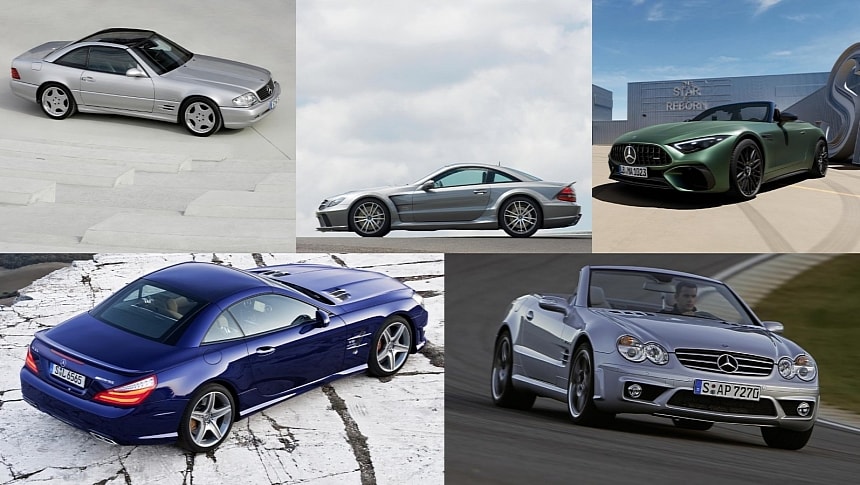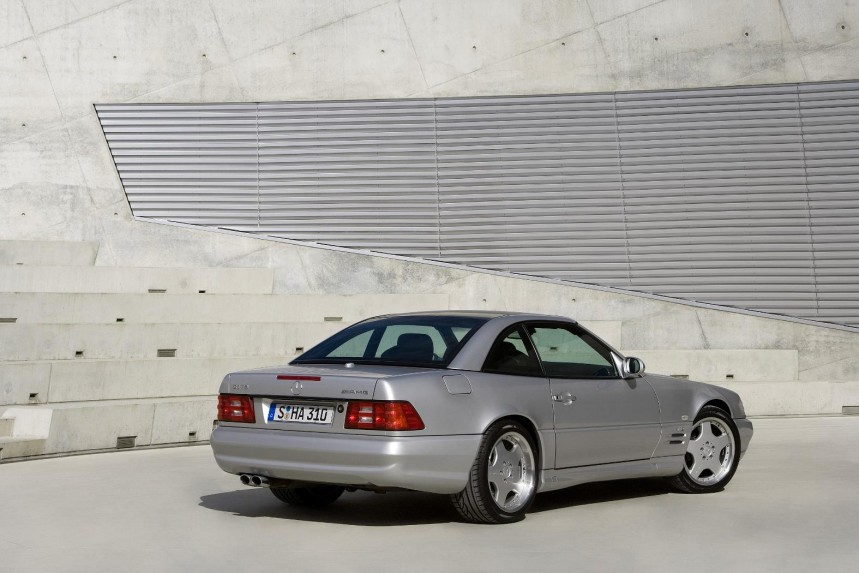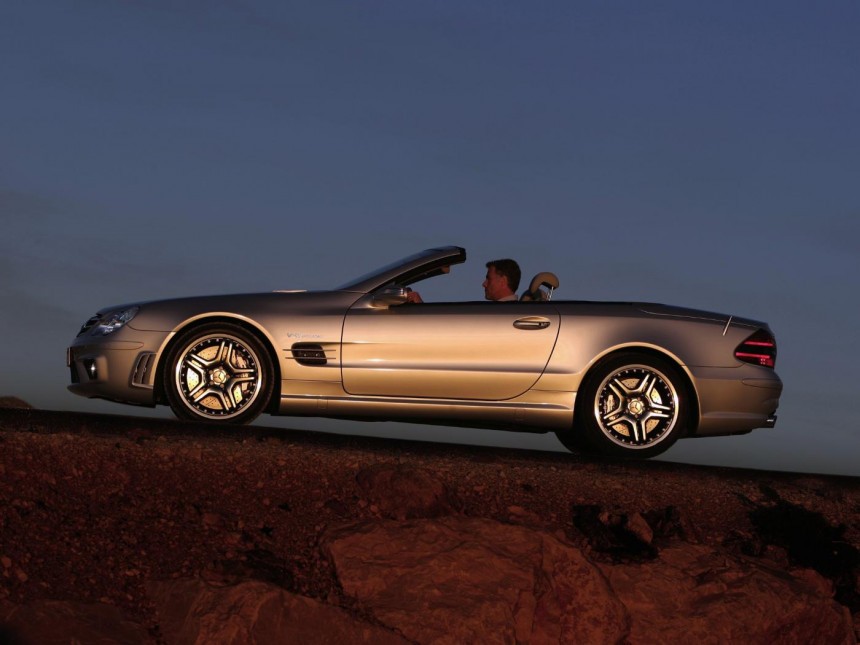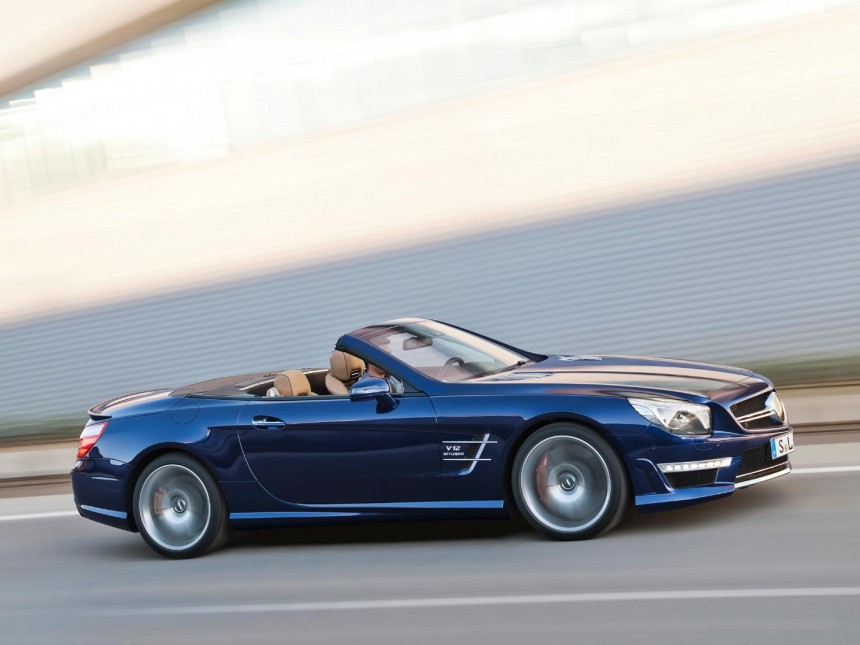Suppose you ask most petrolheads to choose just a handful of quintessential grand touring nameplates of the 20th century. There's no denying that the Mercedes-Benz SL stays tall and proud among all the Bentleys, Maseratis, and Jaguars that usually pop up when somebody mentions iconic GTs.
Also known as the oldest Mercedes-Benz nameplate in continuous production, the SL has had seven different generations since its introduction in 1954.
The original model was forged, like many of the most legendary sports cars, in the crucible of racing, and only arrived on the streets thanks to the request of famous exotic car importer Max Hoffman.
Despite a myriad of identities that the SL has taken over the years, starting from a gull-winged sports coupe, going through a relaxed cruiser era, and then becoming a futuristic GT, the model has retained its high-class aura.
Nowadays, the seventh generation of the model no longer uses the 'Benz' particle in its name as the model has been developed and is exclusively part of the Mercedes-AMG family.
Essentially combining the relaxed and luxurious atmosphere of the now-defunct S-Class Cabriolet with the scalpel-like performance of the equally dead Mercedes-AMG GT Roadster, the current Mercedes-AMG SL has replaced both in equal measure.
Trying to simultaneously play in two different leagues is an art usually reserved for Merc's Stuttgart neighbors from Porsche. Still, the latest SL is well-equipped to deliver on its somewhat antithetical promises and has set its sights on the 911.
Now sporting a 2+2 arrangement last seen on the R129 generation of the nameplate, the R232 Mercedes-AMG SL tries to blend some attributes that have made the Porsche 911 a legend with the characteristics specific to the SLs of yesteryear.
Combining this mix with the sledgehammer traits of old-school AMGs has resulted in the SL 63 S E Performance top-of-the-range version, which has become the most powerful SL in history.
With that in mind, I decided to gather the most powerful SLs of all time in one single article because this isn't the first time the roadster has been transformed into a juggernaut with the help of a massively powerful powertrain.
Without further ado, here are the five most powerful Mercedes SL models in history, starting with the first generation that officially received an AMG makeover.
This rare gem of a car from the mid-'90s is famous for a number of peculiar details and records. The most mind-boggling detail is that even today, it still sports the largest displacement engine under the hood of a road-going Mercedes.
To be fair, that feat is shared with the Mercedes-Benz CLK-GTR Strassenversion SuperSport, which used a more powerful version of the same 7.3-liter V12 engine. Only two of those were ever produced, so the SL 73's record might weigh heavier in that regard.
Returning to the Mercedes-Benz SL 73 AMG, it appeared two years before AMG was officially incorporated under the Mercedes umbrella, but only after the two companies had already established a strong cooperation.
In 1993, AMG, by then renowned for transplanting larger engines into Mercedes-Benz cars and sometimes taking them racing, entered into a partnership with Daimler-Benz AG. This agreement enabled AMG to utilize Daimler-Benz's vast dealership network, paving the way for jointly developed cars.
This means that, although the SL 73 was essentially a tuner car and only 85 units were ever built, all of them could be purchased with a warranty from Mercedes-Benz dealers.
Just like its predecessors, in the shape of the V8-powered SL 60 and V12-powered SL 70 and SL 72, the Mercedes-Benz SL 73 AMG was based on the R129 generation of the long-lasting nameplate. Its massive 7.3-liter V12 was the passenger car engine with the second-highest displacement on the planet at the time and among the most powerful, including supercars of the era.
The naturally aspirated power unit was based on the 6.0-liter V12 that powered Mercedes 600 models at the time, including the SL 600. It produced an astonishing 518 HP (525 PS) and 553 lb-ft of torque, which remains impressive even by today's standards.
Apart from the engine, AMG engineers had also worked their magic on the brakes and suspension, while the exterior design was as subdued as other AMGs from the era. In fact, the only way to differentiate an SL 500 with an AMG body kit from the mighty SL 73 was by looking at the brakes or the rear '73' badge.
As a fun fact, the 7.3-liter V12 was not only shared with the CLK-GTR Strassenversion SuperSport but also made an appearance under the sculpted body of the Pagani Zonda S 7.3.
Three years after the SL 73 went out of production and five years after AMG cars had become part of the official Mercedes-Benz lineup, the fifth generation of the SL was in full swing, and so were its AMG versions.
The R230 was an abrupt departure from all its predecessors, with an all-new design, powertrains, and a retractable hardtop as a party piece. The top-of-the-range V12 in the SL 600 was now twin-turbocharged, allowing AMG engineers a much better base for upgrades.
Launched in 2004, the SL 65 AMG took the baton from the SL 73 as the most powerful Mercedes roadster to date and did it in a spectacular fashion.
The twin-turbocharged 6.0-liter V12 developed a staggering 604 HP (612 PS) and 738 lb-ft (1,000 Nm) of torque. If you don't think that wasn't enough to kick-start a dying star, you must learn that the actual torque figure was 885 lb-ft (1,200 Nm), but it was limited after it was found that the transmission wasn't able to cope with it all without exploding.
Speaking of which, despite Mercedes having already introduced a 7-speed automatic by then, the only transmission able to handle even the limited torque figures was the old and trusty 5G-Tronic.
This meant that, despite the tire-torturing power figures, the SL 65 AMG was more of a relaxed cruiser, unfit for the racetrack but unbeatable on the German Autobahn.
Unlike its predecessors, the model was not a limited-edition wonder but actually became part of the SL lineup for years (and generations) to come.
While the SL's sixth generation had transitioned from a steel to a mostly aluminum body and the roadster had become a lot more high-tech, most of its powertrains were still carryovers from the old one, including the twin-turbo V12 from its predecessor.
That said, the R231 was the first SL generation to no longer feature a non-AMG 600 version, with the V12 having been reserved for the SL 65 AMG model.
The gargantuan powertrain was now paired with a reinforced 7-speed transmission that AMG engineers had modified for quicker shifts, while the engine was massaged to deliver 621 HP (630 PS) and the same 738 lb-ft (1,000) limited torque figures.
Thanks to the 309 lbs (140 kg) lighter body, the much more responsive 7-speed transmission, and the extra horsepower, the R231 SL 65 AMG was able to accelerate from 0 to 62 mph (100 kph) in way under 4 seconds, making it the quickest of its kind.
That said, the SL, on the whole, was still as confused as ever, with the AMG versions having the power of supercars but the cars themselves being relaxing Grand Tourers.
As I mentioned before, the longest-enduring Mercedes nameplate has seen its fair share of troubled waters and it came close to being pulled out from the market more than once over the years. It wasn't like this all the time, though, as the next car on this list is about to prove.
Jumping back into the R230 generation for a particularly dark reason, as the first SL 65 AMG had an evil cousin whose power and performance trumped all SLs before and after it, at least until the current R232 arrived.
Officially called the SL 65 AMG Black Series, the model wasn't even a roadster anymore after the nutty engineers from Affalterbach had finished modifying it.
Compared to the 'regular' SL 65 AMG, the Black Series was 250 kg (551 lbs) lighter thanks to the heavy use (pun intended) of Carbon Fiber Reinforced Plastic (CFRP) and the deletion of the car's retractable hardtop, which had transformed it into a coupe.
The fixed roof not only helped save weight and improve the body rigidity but also made room for a retractable rear wing inside the trunk lid. Other modifications included a 97 mm wider body, made obvious by the flared wheel arches, improved brakes, GT3-like aero parts, and a custom-developed suspension.
The cherry on the cake was obviously the engine, whose output now sat at a stratospheric 661 HP (670 PS) thanks to 12 percent larger turbochargers and improved wastegate ducts.
All these modifications not only translated into a 200+ mph (322+ kph) top speed and a sub-4 seconds acceleration from 0 to 62 mph, but they also made the car the most track-ready SL in history.
Don't think of it as an answer to the Porsche 911 GT3 RS, though, since despite its CFRP diet, we are still talking about a heavy beast due to the use of the old 5G-Tronic and the creature comforts that Mercedes stipulated must still be part of the features list.
No less than 16 years and two model generations had passed since the mighty SL 65 AMG Black Series became the undefeated power champion in the Mercedes SL saga, but, like most epic adventures, the latest hero to be introduced in the story is always the best one.
Wearing the R232 moniker in Stuttgart-speak, the latest SL is no longer a Benz affair, instead being exclusively part of the Mercedes-AMG lineup. This is because the R232 was developed from the ground up by AMG, not Mercedes, and it has been positioned as the open-top and more comfortable brother to the GT Coupe.
Sharing the same architecture, interior, and powertrains as the GT, the latest SL mature into a sports car with supercar performance and grand touring comfort. In other words, it took Mercedes 70 years to bring back the SL to its roots, as the original Gullwing had the exact same attributes.
On top of it, it is the first ever SL with all-wheel-drive, and AMG has also reintroduced a 2+2 seating option on the model, a feature last seen on the R129 generation, or the first one to be officially modified by AMG and sold through Mercedes.
No longer featuring a V12 up front, the latest SL can be had as either a four-cylinder for the entry-level version, reminiscing the 190 SL, or as a twin-turbo V8 in different states of tune and configuration. The big Kahuna is the recently revealed SL 63 S E Performance, where a twin-turbocharged 4.0-liter V8 on the front axle is combined with an electric drive unit on the rear axle.
In translation, the 604 HP (612 PS) from the internal combustion engine is paired with a 201 HP (204 PS) electric motor, resulting in a monstrous 805 HP (816 PS) and an insane 1,047 lb-ft (1,420 Nm) of torque sent to all four wheels.
The maximum output isn't even the biggest news, as the technology required to make everything work might be even more impressive. You see, the electric motor is integrated into the so-called rear drive unit, which also features a dedicated two-speed transmission and a mechanical limited-slip differential.
The V8 up front is paired with its own 9-speed automatic transmission that has had its torque converter replaced with a multi-clutch system by AMG engineers. On top of the rear drive units sits an innovative high-performance battery, which has individually cooled cells and allows an 'always on' approach to the hybrid system.
Featuring lithium-ion tech, the 6.1 kWh battery also allows a measly 8 miles (13 km) of zero-emission driving and can also be charged from a plug. In other words, we are talking about a V8-powered hybrid that is also a PHEV.
The battery normally delivers about 94 HP (95 PS) of continuous power to supplement the V8 and has the entire 201 HP output in various driving modes when the charge allows it. In other words, it has been designed for fast power delivery and charging, not for electric range.
The original model was forged, like many of the most legendary sports cars, in the crucible of racing, and only arrived on the streets thanks to the request of famous exotic car importer Max Hoffman.
Despite a myriad of identities that the SL has taken over the years, starting from a gull-winged sports coupe, going through a relaxed cruiser era, and then becoming a futuristic GT, the model has retained its high-class aura.
Nowadays, the seventh generation of the model no longer uses the 'Benz' particle in its name as the model has been developed and is exclusively part of the Mercedes-AMG family.
Essentially combining the relaxed and luxurious atmosphere of the now-defunct S-Class Cabriolet with the scalpel-like performance of the equally dead Mercedes-AMG GT Roadster, the current Mercedes-AMG SL has replaced both in equal measure.
Trying to simultaneously play in two different leagues is an art usually reserved for Merc's Stuttgart neighbors from Porsche. Still, the latest SL is well-equipped to deliver on its somewhat antithetical promises and has set its sights on the 911.
Now sporting a 2+2 arrangement last seen on the R129 generation of the nameplate, the R232 Mercedes-AMG SL tries to blend some attributes that have made the Porsche 911 a legend with the characteristics specific to the SLs of yesteryear.
Combining this mix with the sledgehammer traits of old-school AMGs has resulted in the SL 63 S E Performance top-of-the-range version, which has become the most powerful SL in history.
With that in mind, I decided to gather the most powerful SLs of all time in one single article because this isn't the first time the roadster has been transformed into a juggernaut with the help of a massively powerful powertrain.
Without further ado, here are the five most powerful Mercedes SL models in history, starting with the first generation that officially received an AMG makeover.
Mercedes-Benz SL 73 AMG (R129) - 518 HP (525 PS)
To be fair, that feat is shared with the Mercedes-Benz CLK-GTR Strassenversion SuperSport, which used a more powerful version of the same 7.3-liter V12 engine. Only two of those were ever produced, so the SL 73's record might weigh heavier in that regard.
Returning to the Mercedes-Benz SL 73 AMG, it appeared two years before AMG was officially incorporated under the Mercedes umbrella, but only after the two companies had already established a strong cooperation.
In 1993, AMG, by then renowned for transplanting larger engines into Mercedes-Benz cars and sometimes taking them racing, entered into a partnership with Daimler-Benz AG. This agreement enabled AMG to utilize Daimler-Benz's vast dealership network, paving the way for jointly developed cars.
This means that, although the SL 73 was essentially a tuner car and only 85 units were ever built, all of them could be purchased with a warranty from Mercedes-Benz dealers.
Just like its predecessors, in the shape of the V8-powered SL 60 and V12-powered SL 70 and SL 72, the Mercedes-Benz SL 73 AMG was based on the R129 generation of the long-lasting nameplate. Its massive 7.3-liter V12 was the passenger car engine with the second-highest displacement on the planet at the time and among the most powerful, including supercars of the era.
The naturally aspirated power unit was based on the 6.0-liter V12 that powered Mercedes 600 models at the time, including the SL 600. It produced an astonishing 518 HP (525 PS) and 553 lb-ft of torque, which remains impressive even by today's standards.
Apart from the engine, AMG engineers had also worked their magic on the brakes and suspension, while the exterior design was as subdued as other AMGs from the era. In fact, the only way to differentiate an SL 500 with an AMG body kit from the mighty SL 73 was by looking at the brakes or the rear '73' badge.
As a fun fact, the 7.3-liter V12 was not only shared with the CLK-GTR Strassenversion SuperSport but also made an appearance under the sculpted body of the Pagani Zonda S 7.3.
Mercedes-Benz SL 65 AMG (R230) - 604 HP (612 PS)
The R230 was an abrupt departure from all its predecessors, with an all-new design, powertrains, and a retractable hardtop as a party piece. The top-of-the-range V12 in the SL 600 was now twin-turbocharged, allowing AMG engineers a much better base for upgrades.
Launched in 2004, the SL 65 AMG took the baton from the SL 73 as the most powerful Mercedes roadster to date and did it in a spectacular fashion.
The twin-turbocharged 6.0-liter V12 developed a staggering 604 HP (612 PS) and 738 lb-ft (1,000 Nm) of torque. If you don't think that wasn't enough to kick-start a dying star, you must learn that the actual torque figure was 885 lb-ft (1,200 Nm), but it was limited after it was found that the transmission wasn't able to cope with it all without exploding.
Speaking of which, despite Mercedes having already introduced a 7-speed automatic by then, the only transmission able to handle even the limited torque figures was the old and trusty 5G-Tronic.
This meant that, despite the tire-torturing power figures, the SL 65 AMG was more of a relaxed cruiser, unfit for the racetrack but unbeatable on the German Autobahn.
Unlike its predecessors, the model was not a limited-edition wonder but actually became part of the SL lineup for years (and generations) to come.
Mercedes-Benz SL 65 AMG (R231) - 621 HP (630 PS)
That said, the R231 was the first SL generation to no longer feature a non-AMG 600 version, with the V12 having been reserved for the SL 65 AMG model.
The gargantuan powertrain was now paired with a reinforced 7-speed transmission that AMG engineers had modified for quicker shifts, while the engine was massaged to deliver 621 HP (630 PS) and the same 738 lb-ft (1,000) limited torque figures.
Thanks to the 309 lbs (140 kg) lighter body, the much more responsive 7-speed transmission, and the extra horsepower, the R231 SL 65 AMG was able to accelerate from 0 to 62 mph (100 kph) in way under 4 seconds, making it the quickest of its kind.
That said, the SL, on the whole, was still as confused as ever, with the AMG versions having the power of supercars but the cars themselves being relaxing Grand Tourers.
As I mentioned before, the longest-enduring Mercedes nameplate has seen its fair share of troubled waters and it came close to being pulled out from the market more than once over the years. It wasn't like this all the time, though, as the next car on this list is about to prove.
Mercedes-Benz SL 65 AMG Black Series (R230) - 661 HP (670 PS)
Officially called the SL 65 AMG Black Series, the model wasn't even a roadster anymore after the nutty engineers from Affalterbach had finished modifying it.
Compared to the 'regular' SL 65 AMG, the Black Series was 250 kg (551 lbs) lighter thanks to the heavy use (pun intended) of Carbon Fiber Reinforced Plastic (CFRP) and the deletion of the car's retractable hardtop, which had transformed it into a coupe.
The fixed roof not only helped save weight and improve the body rigidity but also made room for a retractable rear wing inside the trunk lid. Other modifications included a 97 mm wider body, made obvious by the flared wheel arches, improved brakes, GT3-like aero parts, and a custom-developed suspension.
The cherry on the cake was obviously the engine, whose output now sat at a stratospheric 661 HP (670 PS) thanks to 12 percent larger turbochargers and improved wastegate ducts.
All these modifications not only translated into a 200+ mph (322+ kph) top speed and a sub-4 seconds acceleration from 0 to 62 mph, but they also made the car the most track-ready SL in history.
Don't think of it as an answer to the Porsche 911 GT3 RS, though, since despite its CFRP diet, we are still talking about a heavy beast due to the use of the old 5G-Tronic and the creature comforts that Mercedes stipulated must still be part of the features list.
Mercedes-AMG SL 63 S E Performance (R232) - 805 HP (816 PS)
Wearing the R232 moniker in Stuttgart-speak, the latest SL is no longer a Benz affair, instead being exclusively part of the Mercedes-AMG lineup. This is because the R232 was developed from the ground up by AMG, not Mercedes, and it has been positioned as the open-top and more comfortable brother to the GT Coupe.
Sharing the same architecture, interior, and powertrains as the GT, the latest SL mature into a sports car with supercar performance and grand touring comfort. In other words, it took Mercedes 70 years to bring back the SL to its roots, as the original Gullwing had the exact same attributes.
On top of it, it is the first ever SL with all-wheel-drive, and AMG has also reintroduced a 2+2 seating option on the model, a feature last seen on the R129 generation, or the first one to be officially modified by AMG and sold through Mercedes.
No longer featuring a V12 up front, the latest SL can be had as either a four-cylinder for the entry-level version, reminiscing the 190 SL, or as a twin-turbo V8 in different states of tune and configuration. The big Kahuna is the recently revealed SL 63 S E Performance, where a twin-turbocharged 4.0-liter V8 on the front axle is combined with an electric drive unit on the rear axle.
In translation, the 604 HP (612 PS) from the internal combustion engine is paired with a 201 HP (204 PS) electric motor, resulting in a monstrous 805 HP (816 PS) and an insane 1,047 lb-ft (1,420 Nm) of torque sent to all four wheels.
The maximum output isn't even the biggest news, as the technology required to make everything work might be even more impressive. You see, the electric motor is integrated into the so-called rear drive unit, which also features a dedicated two-speed transmission and a mechanical limited-slip differential.
The V8 up front is paired with its own 9-speed automatic transmission that has had its torque converter replaced with a multi-clutch system by AMG engineers. On top of the rear drive units sits an innovative high-performance battery, which has individually cooled cells and allows an 'always on' approach to the hybrid system.
Featuring lithium-ion tech, the 6.1 kWh battery also allows a measly 8 miles (13 km) of zero-emission driving and can also be charged from a plug. In other words, we are talking about a V8-powered hybrid that is also a PHEV.
The battery normally delivers about 94 HP (95 PS) of continuous power to supplement the V8 and has the entire 201 HP output in various driving modes when the charge allows it. In other words, it has been designed for fast power delivery and charging, not for electric range.































